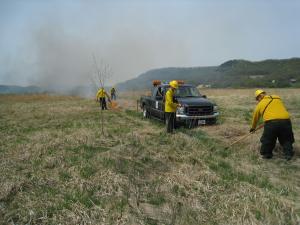Toolbox Home
Introduction
The maintenance of pollinator plantings can be more challenging than other types of plantings due to the high wildflower diversity and difficulty of removing weeds without harming native plants or pollinators. It is also important to leave areas un-mowed or burned in the fall to provide winter nesting habitat. Maintenance methods should be selected that will be the most efficient and cost-effective for the project. These methods should be included in an operation and maintenance plan for the project.
Maintenance activities are often combined, such as mowing or burning followed by hand pulling or spot herbicide application. Maintenance methods will also vary depending on the size of projects and plant species that are present. For example, hand weeding may be the most common method of maintaining small urban plantings while mowing or prescribed burning may be used for larger conservation plantings. The following information summarizes key considerations for different types of project maintenance. Additional information can be found in a Minnesota DNR document that summarizes invertebrate conservation guidelines with a focus on prairie, savanna and grassland ecosystems.
Mowing
Urban Scale Projects: Large mowing equipment should not be used for urban scale projects but pruning shears may be used to decrease the height of vegetation in the fall or spring. Stems should be left about two to three feet tall in the fall to provide nesting sites for cavity nesting bees, but as the plants are pruned upper parts of the plant can be chopped into smaller pieces to be used as mulch to suppress weeds and add organic content to the soil. Seedheads should be left for plant propagation to the extent possible.
Larger Conservation Plantings: During the first two years as projects establish it is often necessary to mow annual and biennial weeds to 5-8 inches with a flail-type mower as needed to provide sunlight and decrease competition for native plant seedlings. Spot mowing of weeds may be needed after the planting is established (year 3 and after) to prevent weed seed production, though it is important to leave plant stems for pollinator nesting, and seedheads for plant propagation to the extent possible.
Hand Weeding
Urban Scale Projects: Hand weeding is the most common type of maintenance for small projects. This is often most effective after rainfall when weeds are easier to pull, and there is less soil disturbance. Digging can also be used to remove clumps of invasive grasses.
Larger Conservation Plantings: Hand weeding can be conducted for larger plantings when there are scattered weeds that may seed into the project such an biennial thistles. In some cases it is sufficient to collect seedheads from annual or biennial (short lived) species.
Prescribed Burning
Urban Scale Projects: Burning can be a challenge for small urban projects as neighbors may be sensitive to smoke. However, with enough planning and communication it is possible to burn urban plantings. It is important to work with local officials when planning a burn and to hire qualified contractors.
Larger Conservation Plantings: Prescribed burning following burn plans is a common practice for larger conservation projects. Prescribed burning helps maintain diversity and control woody species after establishment. Burning should only be conducted on one-quarter to one-half of large sites each year to minimize impact on insects. Patchy burns are ideal to provide areas of refuge for wildlife. Burns are often done in the fall or early spring before plants emerge (every 3-5 years) to promote floral diversity and minimize impacts on pollinators.
Conservation Grazing
Urban Scale Projects: Grazing typically isn't practical for smaller urban projects. However, goats are being used in some urban areas to control invasive shrubs. University of Minnesota researchers are assessing the impacts of goat grazing on buckthorn.
Larger Conservation Plantings: Conservation grazing following grazing plans can be used to reduce the percent of cool-season grasses in conservation plantings that can compete with wildflowers. The timing and intensity of grazing is important to control target weeds while promoting wildflowers.
Spot Herbicide Application
Urban Scale Projects: Hand weeding or using mulches to suppress weeds is typically the first preference for urban scale projects. Herbicides are sometimes used for perennial grasses that are particularly to remove by hand weeding.
Larger Conservation Plantings: Some perennial weeds (such as Canada thistle and Reed canary grass) are most effectively removed through spot herbicide treatment, but should only be sprayed when target species are not in bloom. Many species can be spot mowed early in the season to prevent seeding and treated in mid to late fall. Herbicide application should only be used to the extent necessary for projects to minimize damage to non-target weeds.
Biocontrol
Urban Scale Projects: Hand weeding is typically a sufficient maintenance strategy to manage weeds, decreasing the need for using biocontrol insects.
Larger Conservation Plantings: The use of biocontrol insects is a long-term maintenance strategy to minimize herbicides and control weeds and invasive species. Biocontrol insects are available for Leafy spurge, Spotted knapweed, Purple loosestrife, and Canada thistle. Insects are most often obtained from collecting them from locations where they have been released to control invasive species. The Minnesota Department of Agriculture should be contacted for questions about the use of biocontrol insects.


